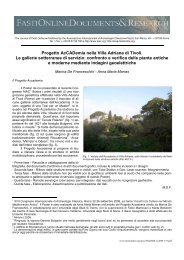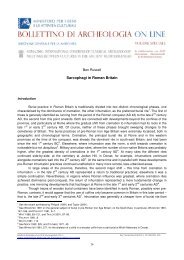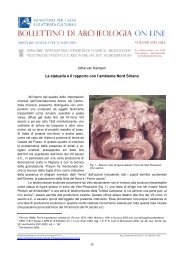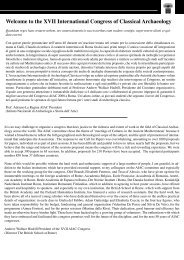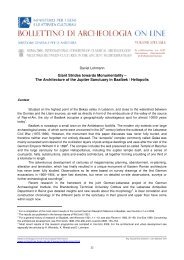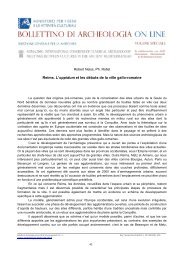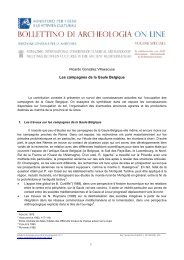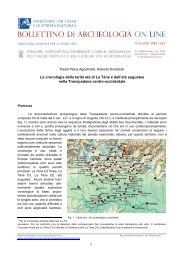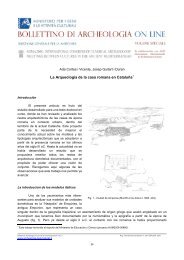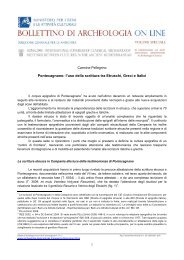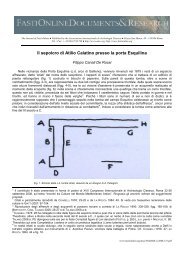Technology: Architectural Innovation in Anatolia - Bollettino di ...
Technology: Architectural Innovation in Anatolia - Bollettino di ...
Technology: Architectural Innovation in Anatolia - Bollettino di ...
Create successful ePaper yourself
Turn your PDF publications into a flip-book with our unique Google optimized e-Paper software.
Mart<strong>in</strong> Bachmann<strong>Technology</strong>: <strong>Architectural</strong> <strong>Innovation</strong> <strong>in</strong> <strong>Anatolia</strong>IntroductionA prime example of technologytransfer occurr<strong>in</strong>g at a relatively early perio<strong>di</strong>s seen <strong>in</strong> the monumental structures of theMycenaean and Hittite cultures. Cyclopeanwalls and corbel vault<strong>in</strong>g are obvious characteristicsshared by both civilizations (fig. 1).Look<strong>in</strong>g deeper at sophisticated constructiontechniques, such as use of the stone-saw,seems to have provided an even stronger<strong>in</strong><strong>di</strong>cation for technical exchange between thetwo centers of the Bronze Age Me<strong>di</strong>terraneanworld 1 .New results from experimental archaeologycarried out by Jürgen Seeher atBoğazköy shows that the often-cited Hittitesaw<strong>in</strong>g technique is <strong>in</strong> fact based upon verysimple pr<strong>in</strong>ciples 2 Fig. 1 – Cyclopean walls <strong>in</strong> Boğazköy (BACHMANN 2006).. Although a cultural exchangeis not ruled out by this <strong>di</strong>scovery, it isnow likely that there could have been an <strong>in</strong>dependent development of the saw<strong>in</strong>g technique, especially givenwell-understood common needs of both Empires. Here we have a good example of Dissem<strong>in</strong>ation Theoryrest<strong>in</strong>g its e<strong>di</strong>fice on shaky foundations. In reality, the support<strong>in</strong>g <strong>in</strong>formation com<strong>in</strong>g from the field of build<strong>in</strong>gtechnology stu<strong>di</strong>es has been too self-conta<strong>in</strong>ed, as a <strong>di</strong>scipl<strong>in</strong>e, and scantily treated thus far, to serve asproof for any general trends. Also, the situation with ancient cultures <strong>in</strong> Asia M<strong>in</strong>or has as yet too muchunexam<strong>in</strong>ed complexity for mak<strong>in</strong>g generalizations. The examples from Asia M<strong>in</strong>or <strong>di</strong>scussed here attemptto place build<strong>in</strong>g activity and <strong>in</strong>novation <strong>in</strong>to a much tighter historical, cultural and scientific context.1 For example MARAN 2004, 270.2 SEEHER 2008, 27–43.Bollett<strong>in</strong>o <strong>di</strong> Archeologia on l<strong>in</strong>e I 2010/ Volume speciale G / G2 / 3 Reg. Tribunale Roma 05.08.2010 n. 330 ISSN 2039 - 0076www.archeologia.beniculturali.it8
XVII International Congress of Classical Archaeology, Roma 22-26 Sept. 2008Session: Cultural contacts and exchange − case stu<strong>di</strong>es from <strong>Anatolia</strong>Fig. 2 – Layout plan of the Karasis fortress (Draw<strong>in</strong>g D. Lorentzen).Case stu<strong>di</strong>es <strong>in</strong> hellenistic architectureThe fortress on the KarasisThe Hellenistic fortress on the Karasis <strong>in</strong> Cilicia demonstrates how for a very large project <strong>in</strong><strong>di</strong>genousbuild<strong>in</strong>g modes were productively comb<strong>in</strong>ed with imported plann<strong>in</strong>g and eng<strong>in</strong>eer<strong>in</strong>g techniques. Theexpansive build<strong>in</strong>g complex lies on top of a mounta<strong>in</strong> of the same name, on the edge of the fruitful Cukurovapla<strong>in</strong> north of modern-day Adana. The ru<strong>in</strong> was only <strong>di</strong>scovered some 10 years ago, and from 2003 to 2006Mustafa Sayar and Adolf Hoffmann conducted a systematic exam<strong>in</strong>ation 3 . An exact documentation of theru<strong>in</strong>s should help with clarify<strong>in</strong>g the central questions about function and dat<strong>in</strong>g.A look at the layout of the fortress shows, <strong>in</strong> the first <strong>in</strong>stance, a skillful use of the <strong>di</strong>fficult topography(fig. 2). The complex is <strong>di</strong>vided <strong>in</strong>to an upper citadel on the highest, elongated spur of the mounta<strong>in</strong> massif,and a lower fortress which secures the southern flank with the entrance area. A long defensive wallspread<strong>in</strong>g far to the east secures both parts.The fortress is completely functional <strong>in</strong> its arrangement and absolutely unadorned, apparently by<strong>in</strong>tent. For an antique build<strong>in</strong>g it is quite extraord<strong>in</strong>arily austere. The only decorative relief, show<strong>in</strong>g a warelephant, adorns one of the towers of the lower fortress (fig. 3). This relief can be understood as a reference3 Prelim<strong>in</strong>ary report at HOFFMANN 2008, 365–468.Bollett<strong>in</strong>o <strong>di</strong> Archeologia on l<strong>in</strong>e I 2010/ Volume speciale G / G2 / 3 Reg. Tribunale Roma 05.08.2010 n. 330 ISSN 2039 - 0076www.archeologia.beniculturali.it9
M. Bachmann – <strong>Technology</strong>: <strong>Architectural</strong> <strong>Innovation</strong> <strong>in</strong> <strong>Anatolia</strong>to Seleucid rule. Despite this lack of iconography,the walls of the Karasis are teem<strong>in</strong>g with<strong>in</strong>formation: <strong>in</strong> ad<strong>di</strong>tion to the relief, numerousmason’s marks are visible on the tower wall.Such mason’s marks appear, <strong>in</strong> chang<strong>in</strong>gdensity, on nearly all wall sections of theKarasis. Some sections appear evenly coveredwith marks. Only the simple rubble walls of thefortress are free from marks, as their materialwas hardly worked. The marks served thus forthe identification of the elaborated stones, <strong>in</strong>towhich some effort was <strong>in</strong>vested. This patternaccords with the oldest examples of build<strong>in</strong>gswith mason’s marks 4 .It is clear that the ashlar blocks weremarked early on <strong>in</strong> the process of their creation.Otherwise there is no explanation for the oftenobservedphenomenon of a truncated mark atthe edge of a block (fig. 4). The truncation musthave occurred when the prefabricated ashlarsreceived their f<strong>in</strong>al preparation for sett<strong>in</strong>g on thesite. Most likely, then, the marks were applie<strong>di</strong>mme<strong>di</strong>ately after preparation <strong>in</strong> the quarry. Thiscorresponds to the topography of the Karasis;the area is so steep and <strong>di</strong>fficult that a transportof stones <strong>in</strong> hardly possible. The build<strong>in</strong>g materialwas quarried <strong>di</strong>rectly on the site, with extractionand terrac<strong>in</strong>g for the build<strong>in</strong>g result<strong>in</strong>gfrom the same process.Fig. 3 – Karasis, tower of the lower fortress (BACHMANN 2005).Hellenistic mason’s marks <strong>in</strong> PergamonFig. 4 – Karasis, truncated mark at the edge of a block(BACHMANN 2004).This phenomenon, the <strong>di</strong>stribution ofmason’s marks applied early <strong>in</strong> the build<strong>in</strong>g process,shows clear parallels to the build<strong>in</strong>g <strong>in</strong>dustry of the so-called Eumenian urban extension at Pergamon 5 .In the first half of the 2nd Century B. C. the town of the older k<strong>in</strong>gdom had been extended by the ad<strong>di</strong>tion ofa considerable area. At the lower parts of the citadel numerous monumental build<strong>in</strong>gs were rapidly erected:the Gymnasion, the Demeter sanctuary 6 and the lower Agora, to mention only the largest. This large-scalebuild<strong>in</strong>g site, as on the Karasis, required complex organization forms, <strong>in</strong> which the mason’s marks seemed tohave played an important role.The mason’s marks of the Eumenian build<strong>in</strong>g activity <strong>in</strong> Pergamon were systematically exam<strong>in</strong>ed <strong>in</strong>the past years (fig. 5). The letters of the Greek alphabet predom<strong>in</strong>ate. Other marks, such as a swastika-likesymbol, hardly appear. Amidst the letters there are also numerous ligatures. Usually two letters wereconnected to a characteristic symbol. Such ligatures are well-known as potter marks. Among the ligatures4 RICHTER 1885, 8–24. Early Investigation of mason’s marks <strong>in</strong> Rome, Pompeji, Perusia-Perugia and Mons Eryx.5 Further <strong>in</strong>vestigations <strong>in</strong> Pergamon’s mason’s marks at BOEHRINGER ET ALII 1937, 78 and SCHAZMANN 1923, 17.6 Excavation report DOERPFELD 1919, 346–524.Bollett<strong>in</strong>o <strong>di</strong> Archeologia on l<strong>in</strong>e I 2010/ Volume speciale G / G2 / 3 Reg. Tribunale Roma 05.08.2010 n. 330 ISSN 2039 - 0076www.archeologia.beniculturali.it10
XVII International Congress of Classical Archaeology, Roma 22-26 Sept. 2008Session: Cultural contacts and exchange − case stu<strong>di</strong>es from <strong>Anatolia</strong>Figg. 6-7 – Diagrams of the prosopografic frequency of <strong>in</strong>itial letters <strong>in</strong> Pergamon and of the frequency of letters <strong>in</strong> Pergamon’s mason’smarks (M. Bachmann).the letter Alpha is noticeably frequent; numerous variants of the Alpha also occur. This is a clear <strong>in</strong><strong>di</strong>cationfor an <strong>in</strong>terpretation of the marks as abbreviations of proper names.It is a clear <strong>in</strong><strong>di</strong>cation, because the prosopografic frequency of Alpha <strong>in</strong> Pergamon (fig. 6) is just assignificantly above average as its occurrence amidst the well-known mason marks of the Hellenistic city (fig.7). This is can be seen by compar<strong>in</strong>g the two <strong>di</strong>agrams shown. The build<strong>in</strong>g <strong>in</strong>dustry of the Hellenisticmetropolis <strong>in</strong> the west of Asia M<strong>in</strong>or was thus determ<strong>in</strong>ed by hierarchical organization forms, which weresub<strong>di</strong>vided <strong>in</strong>to <strong>in</strong><strong>di</strong>vidual craftsman or wage entrepreneur structures. The marks served therefore both ascertificate of performance as well as organization aid – for example for the dest<strong>in</strong>ation of the material. Thusthey <strong>in</strong><strong>di</strong>cated orig<strong>in</strong> and regulation at the same time.Mason’s marks and build<strong>in</strong>g technique on theKarasisIt is possible that the mason’s marks onthe Karasis served a similar function. A certa<strong>in</strong>form of build<strong>in</strong>g organization developed <strong>in</strong> thewestern centers of Asia M<strong>in</strong>or seems thus tohave been transferred <strong>in</strong>to the Cilician prov<strong>in</strong>ce 7 .However, a closer look at the Karasis marksshows some clear <strong>di</strong>fferences, <strong>in</strong> contrast to thesituation at Pergamon. The Karasis marks <strong>in</strong>cludea large number of trivial, non-alphabeticmarks such as po<strong>in</strong>ts or simple symbols (fig. 8).The simple po<strong>in</strong>ts were at first not recognized oridentified as mason’s marks, so unusual wasFig. 8 – Karasis, po<strong>in</strong>ts as mason’s marks (BACHMANN 2005). their form. With these simple marks nativeCilician craftsmen could have adjusted themselvesto work<strong>in</strong>g under an alien organizationalmode. The Greek letters then stand symbolically for this <strong>in</strong>novative alien build<strong>in</strong>g practice, whoserepresentatives acted as consultants.There are variations <strong>in</strong> the masonry techniques on the Karasis, and as expected, there arecorrespond<strong>in</strong>gly <strong>di</strong>fferent mark<strong>in</strong>g systems. Certa<strong>in</strong> build<strong>in</strong>gs on the Karasis have elaborate ashlars with7 A similiar phenomenon <strong>in</strong> earlier periods was suggested for the Carian stone masons: DRESSLER 1966, 73–76; FRANKLIN 2001, 107–116; GOSLINE 1992, 43–50 and GUSMANI 1988, 27–34.Bollett<strong>in</strong>o <strong>di</strong> Archeologia on l<strong>in</strong>e I 2010/ Volume speciale G / G2 / 3 Reg. Tribunale Roma 05.08.2010 n. 330 ISSN 2039 - 0076www.archeologia.beniculturali.it11
M. Bachmann – <strong>Technology</strong>: <strong>Architectural</strong> <strong>Innovation</strong> <strong>in</strong> <strong>Anatolia</strong>drafted marg<strong>in</strong>s. These drafted-marg<strong>in</strong>ashlars are hardly ever signed with nativeCilician symbols, such as the po<strong>in</strong>ts. Thusthis k<strong>in</strong>d of masonry technique might be amore <strong>di</strong>rect transfer of technology <strong>in</strong> the2nd century B.C., which raises the question:what were the extant build<strong>in</strong>g practices<strong>in</strong> Cilicia before the transfer?There was, first of all, a very sophisticatedtra<strong>di</strong>tion of stonework, <strong>in</strong>volv<strong>in</strong>gcomplex masonry techniques. Characteristicis the closely and carefullyfitted polygonal masonry, which is transformedat the corners of the build<strong>in</strong>g <strong>in</strong>torectangular ashlar masonry, illustrated bya Hellenistic period tower (fig. 9) <strong>in</strong> Meydankale(Olba region). Technical detailsFig. 9 – Hellenistic tower <strong>in</strong> Meydankale, Cilicia (courtesy ROOS 2004).such as a hardly visible, but highly effectiverelief of a door l<strong>in</strong>tel with a jackarch are typical of the <strong>in</strong><strong>di</strong>genous craftsmanship.The established masonry techniques were exploited when the fortress was erected, but for new andunusual architectural forms. Included among these new elements is a remarkable Symposia build<strong>in</strong>g of theupper fortress, which allowed the <strong>in</strong>jection of manorial life <strong>in</strong>to the purely functional fortress architecture 8 .Us<strong>in</strong>g the mason’s marks, the development process of the Symposia build<strong>in</strong>g could be exactlyreconstructed (fig. 10). For each step of the process the exist<strong>in</strong>g terra<strong>in</strong> and its stone resources were skillfullyemployed. Extremely similar procedures may be presumed for the Eumenian build<strong>in</strong>gs of Pergamon. Thequestion which now follows is whether the <strong>in</strong>novative build<strong>in</strong>g <strong>in</strong>dustry of the Hellenistic fortress showed<strong>di</strong>rect consequences for the further architectural development <strong>in</strong> Cilicia, as it should do to be regarded as alast<strong>in</strong>g <strong>in</strong>novation process.Fig. 10 – Karasis, development process of the Symposia build<strong>in</strong>g (M. Bachmann, G. Hell).8 HOFFMANN ET ALII 2007, 416–423 and 438–441.Bollett<strong>in</strong>o <strong>di</strong> Archeologia on l<strong>in</strong>e I 2010/ Volume speciale G / G2 / 3 Reg. Tribunale Roma 05.08.2010 n. 330 ISSN 2039 - 0076www.archeologia.beniculturali.it12
XVII International Congress of Classical Archaeology, Roma 22-26 Sept. 2008Session: Cultural contacts and exchange − case stu<strong>di</strong>es from <strong>Anatolia</strong>Fig. 11 – The southern church of Akören II<strong>Innovation</strong> (courtesy ROOS<strong>in</strong> 2005). roman architecture of Asia M<strong>in</strong>orFig. 12 – Karasis, storehouse (BACHMANN 2005).Further development <strong>in</strong> CiliciaIt seems that there was little last<strong>in</strong>g impactof the <strong>in</strong>ventions of the Karasis <strong>in</strong> Cilicia. Cilicia rema<strong>in</strong>edfaithful to her own stonework tra<strong>di</strong>tionsthrough and beyond the Roman period, apparentlyunaffected by their <strong>in</strong>novations, as this example ofearly Byzant<strong>in</strong>e architecture of Akören shows (fig.11). The masonry of this church was produced <strong>in</strong>the same, careful technology as already existedseven hundred years before 9 . General rules for thedat<strong>in</strong>g of masonry techniques fail here miserablybecause of the cont<strong>in</strong>uity.The magnificent masonry of ashlars withdrafted marg<strong>in</strong>s (Rustika), with which certa<strong>in</strong> build<strong>in</strong>gof the Karasis fortress were emphasized, like-Fig. 13 – Andriake, horrea hadriani (BACHMANN 2007).wise rema<strong>in</strong>ed without <strong>di</strong>rect successors. Here aview of the remarkable storehouse of the fortress (fig. 12). Much later this technique appears aga<strong>in</strong> <strong>in</strong> Ciliciawith the Roman horrea hadriani <strong>in</strong> Andriake 10 . It is a po<strong>in</strong>t of <strong>in</strong>terest, that more than three hundred yearslater, for a similar build<strong>in</strong>g function a similar, representative ashlar masonry was used (fig. 13). Innovativeadvances of Roman civil eng<strong>in</strong>eer<strong>in</strong>g rema<strong>in</strong>ed nevertheless usually limited to the large coastal centers andCilicia experienced no further impact.The Red Hall <strong>in</strong> PergamonThis is actually also valid for one of the most remarkable Roman build<strong>in</strong>g complexes <strong>in</strong> Asia M<strong>in</strong>or,the Red Hall <strong>in</strong> Pergamon (fig. 14). The enormous build<strong>in</strong>g complex can be considered the ma<strong>in</strong> urbanemphasis of Roman Pergamon which covered the pla<strong>in</strong> <strong>in</strong> front of the citadel. Presumed to be a cult center,the exact <strong>in</strong>terpretation of the Red Hall’s function is still pend<strong>in</strong>g. Much po<strong>in</strong>ts however to the fact thatimperial Rome had made itself owner of this enormous build<strong>in</strong>g project. In various regards it could be9 WULF 2003, 306–307.10 BORCHARDT 1975, 66–71.Bollett<strong>in</strong>o <strong>di</strong> Archeologia on l<strong>in</strong>e I 2010/ Volume speciale G / G2 / 3 Reg. Tribunale Roma 05.08.2010 n. 330 ISSN 2039 - 0076www.archeologia.beniculturali.it13
M. Bachmann – <strong>Technology</strong>: <strong>Architectural</strong> <strong>Innovation</strong> <strong>in</strong> <strong>Anatolia</strong>Fig. 14 – Red Hall <strong>in</strong> Pergamon (BACHMANN 2008).described as an exposition of the Roman build<strong>in</strong>g<strong>in</strong>dustry, especially put together for thebenefit of Asia M<strong>in</strong>or.First the course of the Sel<strong>in</strong>us river hadto be <strong>di</strong>verted <strong>in</strong>to two huge conduits, <strong>in</strong> order tocreate an enormous build<strong>in</strong>g platform, a monumentaleng<strong>in</strong>eer<strong>in</strong>g achievement. On this platformthe build<strong>in</strong>gs of the Red Hall with theirenormous courtyard were situated.However, the most remarkable <strong>in</strong>novationis the use of bricks for the erection of thema<strong>in</strong> build<strong>in</strong>g, the so-called Basilica. Prior to theRed Hall, build<strong>in</strong>g with bricks was virtually unknown<strong>in</strong> Asia M<strong>in</strong>or. In contrast to opus testaceum,the brick walls of the Red Hall are substantiallythrough-bricked without us<strong>in</strong>g opusFig. 15 – Dome of the southern tower of the Red Hall <strong>in</strong> Pergamon(BACHMANN 2006).caementicium as <strong>in</strong>lay. Tremendous quantitiesbricks had to be manufactured for this task.Not only the through-bricked Basilica walls but also the domes of the two flank<strong>in</strong>g round towers wereerected <strong>in</strong> brick (fig. 15). This seems especially significant, as elsewhere <strong>in</strong> the Red Hall opus caementicium,or Roman concrete, was largely used. Special consideration seems to have been implied through the use ofbrick, and especially regard<strong>in</strong>g the precision of the execution of construction.Special marble pieces were <strong>in</strong>tegrated <strong>in</strong>to the brick walls, which served as the fixed part of aprefabricated wall decoration of white and coloured marble. The build<strong>in</strong>g would have been completelyencrusted with marble; today only a few remnants can be seen.The use of brick masonry was limited to the ma<strong>in</strong> architectural elements. All rema<strong>in</strong><strong>in</strong>g build<strong>in</strong>g partsof the Red Hall were erected with natural stone. Here opus implectum was largely used, <strong>in</strong> a form withrelatively small, easily-handled ashlars, as is often seen subsequently at Pergamon (fig. 16). In this regard,Bollett<strong>in</strong>o <strong>di</strong> Archeologia on l<strong>in</strong>e I 2010/ Volume speciale G / G2 / 3 Reg. Tribunale Roma 05.08.2010 n. 330 ISSN 2039 - 0076www.archeologia.beniculturali.it14
XVII International Congress of Classical Archaeology, Roma 22-26 Sept. 2008Session: Cultural contacts and exchange − case stu<strong>di</strong>es from <strong>Anatolia</strong>Fig. 16 – Reta<strong>in</strong><strong>in</strong>g wall of the Red Hall <strong>in</strong> Pergamon (BACHMANN 2006).at least, the <strong>in</strong>troduction of the Roman build<strong>in</strong>g<strong>in</strong>dustry <strong>in</strong> Asia M<strong>in</strong>or can be called a successstory. Opus implectum with the characteristic,small ashlars was used <strong>in</strong> many Roman build<strong>in</strong>gs.A totally <strong>di</strong>fferent development must benoted concern<strong>in</strong>g the brick technology. Here, theRed Hall <strong>in</strong> Pergamon must be considered as an<strong>in</strong>vestment failure to <strong>in</strong>troduce a new build<strong>in</strong>gand construction technology. Build<strong>in</strong>g with bricksrema<strong>in</strong>ed exceptional <strong>in</strong> Roman Asia M<strong>in</strong>or.ConclusionFig. 17 – Vespasianic bath build<strong>in</strong>g <strong>in</strong> O<strong>in</strong>oanda/Lycia(BACHMANN 2007).The examples shown outl<strong>in</strong>e a rich andmulti-layered <strong>di</strong>versity of features concern<strong>in</strong>g <strong>in</strong>novationprocesses <strong>in</strong> Asia M<strong>in</strong>or. The Hellenisticepoch is characterized by strong <strong>in</strong>novation <strong>in</strong> both areas of craft technique and <strong>in</strong>dustry organization.These <strong>in</strong>novations built upon <strong>in</strong><strong>di</strong>genous developments, and thus <strong>di</strong>splay regional peculiarities. The Romanbuild<strong>in</strong>g <strong>in</strong>dustry was <strong>in</strong>troduced <strong>in</strong> <strong>di</strong>fferent ways. Some <strong>in</strong>novations - like opus implectum - were fastBollett<strong>in</strong>o <strong>di</strong> Archeologia on l<strong>in</strong>e I 2010/ Volume speciale G / G2 / 3 Reg. Tribunale Roma 05.08.2010 n. 330 ISSN 2039 - 0076www.archeologia.beniculturali.it15
M. Bachmann – <strong>Technology</strong>: <strong>Architectural</strong> <strong>Innovation</strong> <strong>in</strong> <strong>Anatolia</strong>established <strong>in</strong> the urban centers; others were not generally accepted <strong>in</strong> relation to pre-exist<strong>in</strong>g strongtra<strong>di</strong>tions. Faraway from the centers of Roman <strong>di</strong>splay of power the strong tra<strong>di</strong>tions of Hellenisticconstruction cont<strong>in</strong>ued for a long time. As for <strong>in</strong>stance <strong>in</strong> this bath build<strong>in</strong>g from the Vespasianic period <strong>in</strong>O<strong>in</strong>oanda/Lycia (fig. 17).Dr.-Ing. Mart<strong>in</strong> BachmannDeutsches Archäologisches Institut - Alman Arkeoloji EnstitüsüInönü Caddesi 10TR-34437 Gümüssuyu-IstanbulFax: 0090 (0)212 393 7614Homepage: http://www.da<strong>in</strong>st.deE-mail: bachmann@istanbul.da<strong>in</strong>st.orgBibliographyBOEHRINGER E., KRAUSS F., 1937. Das Temenos für den Herrscherkult, Altertümer von Pergamon IX.BORCHHARDT J. (ed), 1975. Myra. E<strong>in</strong>e lykische Metropole <strong>in</strong> antiker und byzant<strong>in</strong>ischer Zeit, IstanbulerForschungen, 30, 66–71.BURRER A., 1911. Der Ste<strong>in</strong>hauer bei der Arbeit. Essl<strong>in</strong>gen a. N.DOERPFELD W., 1919. Die Arbeiten zu Pergamon 1908-1909, Mitteilungen des Archäologischen InstitutsAthen 35, 346–524.DRESSLER W., 1966. Karoide Inschriften im Ste<strong>in</strong>bruch von Belevi, Jahreshefte des Österreichischen.Archäologischen Institutes <strong>in</strong> Wien, 48, 73–76.FRANKLIN N., 2001. Mason’s Marks from the N<strong>in</strong>th Century BCE Northern K<strong>in</strong>gdom of Israel. Evidence of theNascent Carian Alphabet?, Kadmos. Zeitschrift für vor- und frühgriechische Epigraphik 40, 107–116.GOSLINE S., 1992. Carian Quarry Mark<strong>in</strong>gs on Elephant<strong>in</strong>e Island, Kadmos. Zeitschrift für vor- undfrühgriechische Epigraphik 31, 43–50.GUSMANI R,1988. ‚Ste<strong>in</strong>metzmarken’ aus Sar<strong>di</strong>s, <strong>in</strong>: Kadmos. Zeitschrift für vor- und frühgriechischeEpigraphik, 27, 27–34.HOFFMANN A. ET ALII, 2007. Vorbericht zu den <strong>in</strong> den Jahren 2003 bis 2005 auf dem Berg Karasis (beiKozan/Adana) und <strong>in</strong> se<strong>in</strong>er Umgebung durchgeführten Untersuchungen, Istanbuler Mitteilungen,57/2007, 365–468.MARAN J., 2004, Architektonische <strong>Innovation</strong> im spätmykenischen Tiryns – Lokale Bauprogramme undfremde Kulture<strong>in</strong>flüsse, Althellenische Technologie und Technik. Ohlstadt, 261–295.RICHTER O. L.,1885. Über antike Ste<strong>in</strong>metzzeichen. Berl<strong>in</strong>.SCHAZMANN P., 1923., Das Gymnasion, Altertümer von Pergamon VI. Berl<strong>in</strong>.SEEHER J., 2008. Sägen wie <strong>di</strong>e Hethiter: Rekonstruktion e<strong>in</strong>er Ste<strong>in</strong>schneidetechnik im bronzezeitlichenBauhandwerk, Istanbuler Mitteilungen, 57/2007, 27–43.WULF U., 2003. Akören. Zur Stadtplanung und Wohnarchitektur zweier Siedlungen <strong>in</strong> Kilikien, Die spätantikeStadt und ihre Christianisierung. Wiesbaden, 299–307.Bollett<strong>in</strong>o <strong>di</strong> Archeologia on l<strong>in</strong>e I 2010/ Volume speciale G / G2 / 3 Reg. Tribunale Roma 05.08.2010 n. 330 ISSN 2039 - 0076www.archeologia.beniculturali.it16



